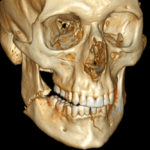
The mandible is involved in between 40-65% of facial fractures and between 25-33% of mandibular fracture involved the angle of the mandible. A number of studies have suggested and increased risk of mandibular angle fractures when third molars are present.
The aim of this review was to assess the relationship between mandibular angle fracture sand the presence of a third molar, and whether its position influences the type of fracture.
Methods
Searches were conducted in the PubMed, Scopus and Cochrane library databases. Prospective and retrospective observational studies published in English with a sample size of 250 or more where trauma was the cause of the angle fracture were considered.
Two reviewers independently selected studies abstracted data and assessed study quality using the Newcastle-Ottawa Scale (NOS). Relative risk (RR) of fracture of mandibular angle and RR of mandibular angle fracture related to the position of mandibular third molar was calculated and meta-analysis carried out.
Results
- 7 retrospective studies were included.
- Sample sizes ranged from 367 – 2033.
- 5 studies reported on the horizontal and vertical position of third molars.
- All 7 studies were classified good on the NOS with 5 out of 8 stars.
| Relative Risk | 95% CI | |
| Overall | 1.90 | 1.47 – 2.46 |
| Pell & Gregory Class A | 1.18 | 0.62 – 2.25 |
| Pell & Gregory Class B | 1.98 | 0.95 – 4.10 |
| Pell & Gregory Class C | 2.72 | 1.78 – 4.16 |
| Pell & Gregory Class I | 1.31 | 0.80 – 2.14 |
| Pell & Gregory Class II | 2.21 | 1.69 – 2.87 |
| Pell & Gregory Class III | 2.99 | 2.12 – 4.22 |
Conclusions
The authors concluded: –
there is a statistically significant association between mandibular angle fracture and third molar presence in patients who present with mandibular fractures, especially if the third molar is incompletely erupted. The strength of this association is particularly relevant when the third molar is located in Class C, Class II, and Class III, according to the Pell and Gregory classification.
Comments
Within the past 12 months we have blogged about two previous reviews of this topic (Dental Elf – 24th Jan 2018 and Dental Elf – 26th Jul 2017). The 2017 review by Armond et al included 35 studies and the 2018 review by Ruela et al included 16 studies. This current review has only included studies published in English with 250 or more patients which is would have had implication for the number of included studies. This new review includes one of two studies that were not included in the earlier reviews although they had been published. All the data for the current review is derived from retrospective cohort which has a greater potential for bias. While all 3 reviews found an increased risk of mandibular angle fracture when third molars were present further clarification of the potential risks could be obtained from high quality prospective studies.
Links
Primary Paper
Giovacchini F, Paradiso D, Bensi C, Belli S, Lomurno G, Tullio A. Association between third molar and mandibular angle fracture: A systematic review and meta-analysis. J Craniomaxillofac Surg. 2018 Apr;46(4):558-565. doi:10.1016/j.jcms.2017.12.011. Epub 2018 Feb 17. Review. PubMed PMID: 29459187.
Other references
Dental Elf – 24th Jan 2018
Mandibular angle fractures – Do third molars have an influence?
Dental Elf – 26th Jul 2017
Catalogue of Bias
Picture credits
By Coronation Dental Specialty Group

[…] post Third molars and mandibular angle fractures: Are they associated? appeared first on National Elf […]